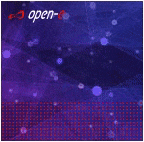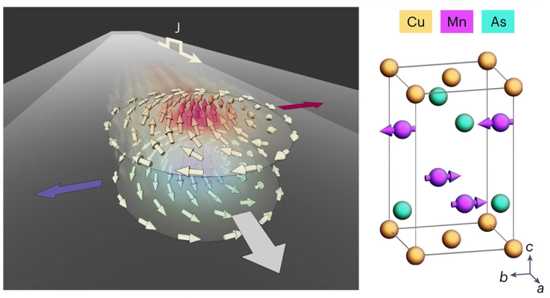University of Nottingham Study: Electrical Creation and Control of Antiferromagnetic Vortices
Magnetic vortices proposed as information carriers in next-gen memory devices
This is a Press Release edited by StorageNewsletter.com on June 2, 2023 at 2:01 pmA new study has shown for the first time how electrical creation and control of magnetic vortices in an antiferromagnet can be achieved, a discovery that will increase the storage capacity and speed of next ge devices.
Researchers from the University of Nottingham’s School of Physics and Astronomy have used magnetic imaging techniques to map the structure of newly formed magnetic vortices and demonstrate their back-and-forth movement due to alternating electrical pulses. Their findings have been published in Nature Nanotechnology.
“This is an exciting moment for us, these magnetic vortices have been proposed as information carriers in next-generation memory devices, but evidence of their existence in antiferromagnets has so far been scarce. Now, we have not only generated them, but also moved them in a controllable way. It’s another success for our material, CuMnAs, which has been at the centre of several breakthroughs in antiferromagnetic spintronics over the last few years,“ said Oliver Amin, research fellow, University of Nottingham, lead author on the study.
CuMnAs has a specific crystal structure, grown in almost complete vacuum, atomic layer by atomic layer. It has been shown to behave like a switch when pulsed with electrical currents, and the research group in Nottingham, led by Dr Peter Wadley, alongside international collaborators, have ‘zoomed in’ on the magnetic textures being controlled; first with the demonstration of moving domain walls, and now with the generation and control of magnetic vortices.
Key to this research is a magnetic imaging technique called photoemission electron microscopy, which was carried out at the UK’s synchrotron facility, Diamond Light Source. The synchrotron produces a collimated beam of polarised x-rays, which is shone onto the sample to probe to magnetic state. This allows for spatially resolution of micromagnetic textures as small as 20 nanometres in size.
Magnetic materials have been technologically important for centuries, from the compass to modern HDDs. However almost all of these materials have belonged to one type of magnetic order : ferromagnetism. This is the type of magnet we are all familiar with from fridge magnets to washing machine motors and computer HDDs. They produce an external magnetic field that we can ‘feel’ because all of the tiny atomic magnetic moments that constitute them like to align in the same direction. It is this field that causes fridge magnets to stick and that we sometimes see mapped out with iron filings.
Because they lack an external magnetic field, antiferromagnets are hard to detect and, until recently, hard to control. For this reason they have found almost no applications. Antiferromagnets produce no external magnetic field because all of the neighboring constituent tiny atomic moments point in exactly opposite directions from each other. In doing so they cancel each other out and no external magnetic field is produced: they won’t stick to fridges or deflect a compass needle.
But antiferromagnets are magnetically more robust and movement of their tiny atomic moments happens approximately 1,000 times faster than a ferromagnet. This could create computer memory which operates far faster than current memory technology.
“Antiferromagnets have the potential to out-compete other forms of memory which would lead to a redesign of computing architecture, huge speed increases and energy savings. The additional computing power could have large societal impact. These findings are really exciting as they bring us closer to realising the potential of antiferromagnet materials to transform the digital landscape,” said Dr Peter Wadley, research lead, University of Nottingham.
Article: Antiferromagnetic half-skyrmions electrically generated and controlled at room temperature
Nature Nanotechnology has published an article written by O. J. Amin, S. F. Poole, School of Physics and Astronomy, University of Nottingham, Nottingham, UK, S. Reimers, School of Physics and Astronomy, University of Nottingham, Nottingham, UK, Diamond Light Source, Chilton, UK, and Institut für Physik, Johannes Gutenberg Universität Mainz, Mainz, Germany, L. X. Barton, A. Dal Din, School of Physics and Astronomy, University of Nottingham, Nottingham, UK, F. Maccherozzi, S. S. Dhesi, Diamond Light Source, Chilton, UK, V. Novák, F. Krizek, Institute of Physics, Czech Academy of Sciences, Prague, Czech Republic, J. S. Chauhan, R. P. Campion, A. W. Rushforth, School of Physics and Astronomy, University of Nottingham, Nottingham, UK, T. Jungwirth, School of Physics and Astronomy, University of Nottingham, Nottingham, UK, and Institute of Physics, Czech Academy of Sciences, Prague, Czech Republic, O. A. Tretiakov, School of Physics, The University of New South Wales, Sydney, New South Wales, Australia, K. W. Edmonds, and P. Wadley, School of Physics and Astronomy, University of Nottingham, Nottingham, UK.
Abstract: “Topologically protected magnetic textures are promising candidates for information carriers in future memory devices, as they can be efficiently propelled at very high velocities using current-induced spin torques. These textures—nanoscale whirls in the magnetic order—include skyrmions, half-skyrmions (merons) and their antiparticles. Antiferromagnets have been shown to host versions of these textures that have high potential for terahertz dynamics, deflection-free motion and improved size scaling due to the absence of stray field. Here we show that topological spin textures, merons and antimerons, can be generated at room temperature and reversibly moved using electrical pulses in thin-film CuMnAs, a semimetallic antiferromagnet that is a testbed system for spintronic applications. The merons and antimerons are localized on 180° domain walls, and move in the direction of the current pulses. The electrical generation and manipulation of antiferromagnetic merons is a crucial step towards realizing the full potential of antiferromagnetic thin films as active components in high-density, high-speed magnetic memory devices.“















 Subscribe to our free daily newsletter
Subscribe to our free daily newsletter

